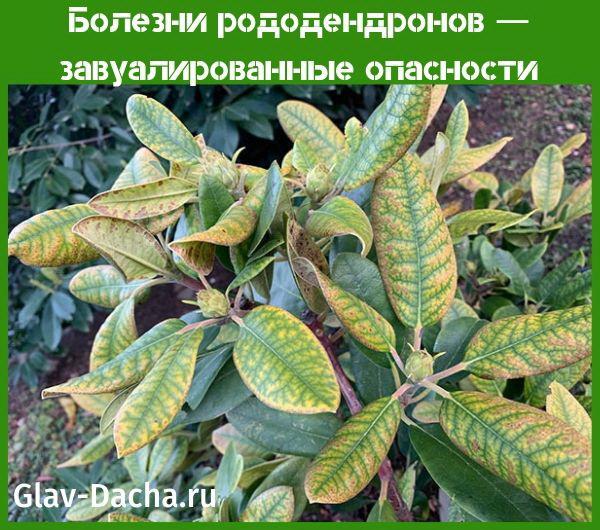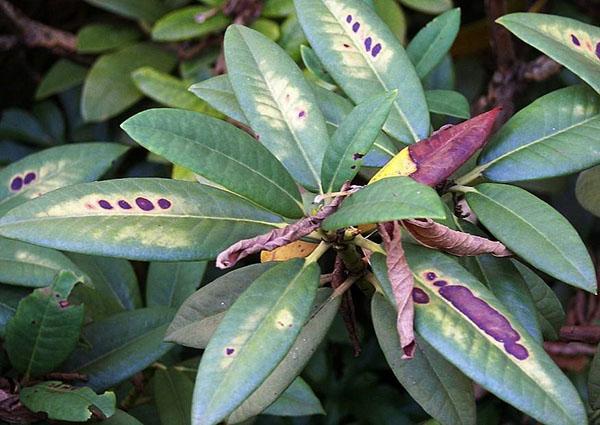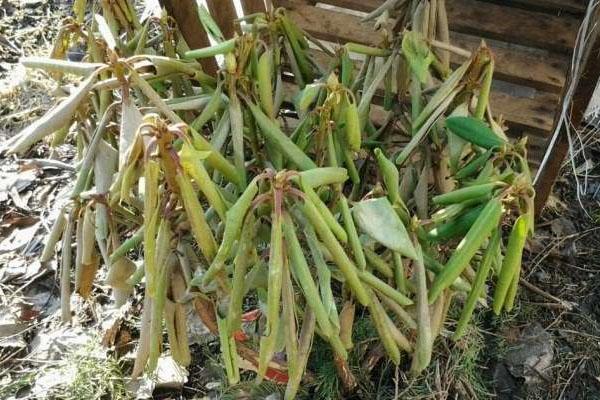Rhododendron diseases - veiled dangers
 Twisted, dry leaves or spots of various types can ruin any ornamental plant. Diseases of rhododendrons are so dangerous that they immediately infect neighboring flower crops. A detailed acquaintance with some of them will help the gardener to take the necessary measures in a timely manner. Knowing the causes of fungal infections, it will be easier for the farmer to prevent the occurrence of dangerous ailments.
Twisted, dry leaves or spots of various types can ruin any ornamental plant. Diseases of rhododendrons are so dangerous that they immediately infect neighboring flower crops. A detailed acquaintance with some of them will help the gardener to take the necessary measures in a timely manner. Knowing the causes of fungal infections, it will be easier for the farmer to prevent the occurrence of dangerous ailments.
Common diseases of rhododendrons

Tracheomycotic wilting or when leaves curl
 Fungal microorganisms infect the root system of the bush, and the underground part begins to rot at an accelerated rate. In this state, it is unable to deliver nutrients to the culture.
Fungal microorganisms infect the root system of the bush, and the underground part begins to rot at an accelerated rate. In this state, it is unable to deliver nutrients to the culture.
The first signs of this rhododendron disease are:
- white bloom on the stems;
- brown spots;
- fast drying of green mass;
- leaf fall (together with petioles);
- wilting of shoots.
 The rhizome is covered with a gray-white mycelium. The process of death of living tissues occurs quickly enough. The main reason why the leaves of rhododendrons curl is the blockage of blood vessels by fungal spores.
The rhizome is covered with a gray-white mycelium. The process of death of living tissues occurs quickly enough. The main reason why the leaves of rhododendrons curl is the blockage of blood vessels by fungal spores.
The infected parts of the bush are removed and disposed of. The remaining stems are treated with a Bordeaux mixture. Prevention - watering and spraying the plant with a solution Fundazola (0,2%).
Yellow leaf mosaic
 Alpine flower varieties are especially affected by this virus. Insects, such as aphids or bed bugs, carry the dangerous infection.
Alpine flower varieties are especially affected by this virus. Insects, such as aphids or bed bugs, carry the dangerous infection.
A photo of this rhododendron disease clearly demonstrates its manifestation:
- yellow-green tint of foliage;
- swollen, dark-colored calluses;
- thin deciduous plate.
In a short period of time bush turns into a terrible sight. If not disposed of, the disease will quickly spread to neighboring crops.
What to do if the leaves of rhododendrons turn yellow? It is worth knowing that such a bush cannot be treated. It is uprooted and burned. The flowerbed is treated with Confidor or another strong insecticide.
Spotting is not Variegata
 Sometimes the plant sheds its foliage prematurely. However, before that, it begins to turn yellow and becomes covered with brown spots of irregular shape. In the dead areas, massive spore colonies are formed in the form of gray pads.
Sometimes the plant sheds its foliage prematurely. However, before that, it begins to turn yellow and becomes covered with brown spots of irregular shape. In the dead areas, massive spore colonies are formed in the form of gray pads.
There are several types of spotting:
- Pestalociic.

- Phylostictic.

- Anthracotic.

- Septoriasis.

The damaged parts of the flower must be cut off. The remaining greens are sprayed with a solution of copper sulfate, Camulos or Bordeaux liquid.
Most of the leaves are dry brown spots with a red border. As the virus progresses, black sporangia appear on the surface.After reviewing the photo of rhododendron diseases and their treatment, it will be much easier to cope with a dangerous enemy.
In order not to harm the culture, all therapeutic measures are carried out at low air humidity. Otherwise, terrible burns will appear on the bush.
Rot in all its forms
 The cause of the onset and development of fungal diseases of rhododendrons is high soil moisture.
The cause of the onset and development of fungal diseases of rhododendrons is high soil moisture.
As a result, brown spots or necrosis appear on:
- young shoots;
- leaves;
- shoots;
- buds;
- roots;
- flower petals.
 With advanced forms of fungal infections, a fluffy coating of a smoky shade forms on the deciduous plates. Sometimes it takes on a filamentous structure, which resembles a web of a web.
With advanced forms of fungal infections, a fluffy coating of a smoky shade forms on the deciduous plates. Sometimes it takes on a filamentous structure, which resembles a web of a web.
The parts of the culture damaged by the fungus are completely destroyed. Then they carefully monitor the condition of the bush.
The best way to combat rot is through prevention. For this, the plantings are sprayed and watered with a 0.2% Fundazole solution or other copper-containing preparations. Activities are held every 2 weeks.
Wax disease is a collective responsibility
 In some cases, the occurrence of infectious diseases can be triggered by several types of fungal spores at once.
In some cases, the occurrence of infectious diseases can be triggered by several types of fungal spores at once.
The main symptoms of rhododendron wax disease are:
- deformation of foliage;
- thickening of deciduous plates;
- the appearance of yellowness;
- reddish brown spotting;
- the formation of white growths.
At the first signs of damage, the evergreen shrub is cut off. Then the crown is sprayed with a solution of the drug Cumulus. Gardeners recommend to carry out the procedure in the spring to improve the effect.
Although these are just some of the rhododendron diseases and their treatments, it is also worth mentioning:
- late blight;
- rust;
- bacterial cancer;
- chlorosis;
- cercosprosis.
 If the tips of the leaves begin to turn yellow, then the plant is suffering from high soil acidity... The bush is sprayed with two types of sulfate: magnesium and iron. The drug is diluted in a ratio of 7 g / l.
If the tips of the leaves begin to turn yellow, then the plant is suffering from high soil acidity... The bush is sprayed with two types of sulfate: magnesium and iron. The drug is diluted in a ratio of 7 g / l.
According to many growers, rhododendron diseases are the result of improper care of the shrub. All he needs is planting in the right place and monitoring the condition of the plant.